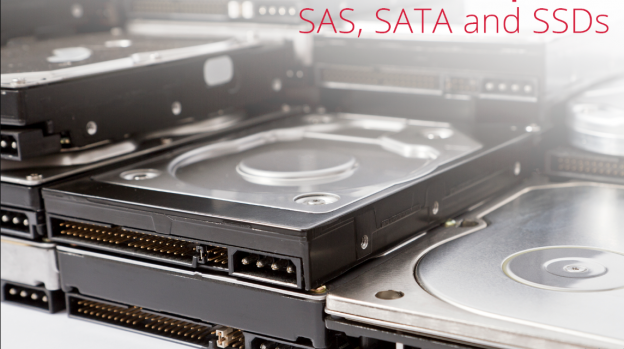| SATA | SAS | SSD | |
|---|---|---|---|
| Acronym | Serial ATA (SATA) | Serial Attached SCSI (SAS) | Solid State Drive (SSD) |
| What is it? | SATA is a storage interface that joins host bus adaptors to data storage devices. | SAS is a known data transfer technology to move data to and from computer storage devices such as hard drives. | SSD is a data storage device that uses electronic circuits as memory for persistent data storage. |
| Benefits | It lets an easy cable routing within a system and increased cable length. | SAS enables multiple devices, regardless of size and type to be connected simultaneously via thinner and longer cables. | SSDs work as a catalyst for the computers’ speed, helping them to boot in no time. |
| It allows for faster transfer rates and improved airflow within the machine. | Its full-duplex signal transmission supports 3.0 Gb/s. | SSD is better resistant to physical shock and does not make noise and has less latency. | |
| It has efficient interface as compared to standard data storage devices. | SAS cables and connectors are highly cost efficient than parallel bus architectures. | SSD has high durability and is far resistant to shocks as it has no movable parts. | |
| Independent bus leads to no bandwidth competition. | |||
| USP | SATA transfer data at 150MBps, whereas its predecessors lost at 100MBps | SAS can access several buses and support multiple connections simultaneously, enhancing bandwidth irrespective of the bit rate of transmission. | SSD leverages electronic interfaces, promising high compatibility with traditional block I/O hard disk drives. This allows for efficient replacements in even common apps. |
| Structure | It is a data cable with its physical design based on Fibre Channel adopting 4-core wire. It uses 7 conductors, leading to less electromagnetic interference and is a complete duplex protocol. It supports continuous flow of signals from each device moving down the bus. | A solid state drive consists of 6 layers, including physical layer, link layer, PHY layer, port layer, transport layer, and application layer. | SSD is composed of a controller and memory. The controller connects NAND memory components to the host computer. And the memory stores the data.The key memory component, nowadays, is NAND flash non-volatile memory, capable of storing data without power. On the other hand, earlier SSDs used DRAM volatile memory. |
| Compatibility | SATA lets using an adapter to offer parallel device compatibility. The adapter has an ability to convert parallel signal from mother board to serial signal workable on SATA. | Devices with SAS have a great compatibility with SATA devices. And the devices that employ earlier SCSI technologies. | SSDs offered by different brands show different compatibility with different machines. Undoubtedly, SSDs are fast and must be chosen on the basis of your choice of high speed, need for memory, reliability, and version of machine. |
Dedicated Server Hosting > Blog > What Differentiates SATA, SAS and SSD?







 Live Chat
Live Chat